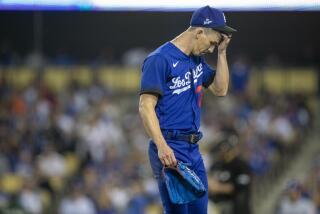ALL-STAR DOCTORS : Centinela Hospital Has Become Leader in Sports Medicine
- Share via
As one ventures into the Biomechanics Research Laboratory of the Centinela Hospital Medical Center, it might appear as if time has been advanced.
This isn’t a motion-picture version of a laboratory with foul-smelling potions and curious test tubes.
Yet, the sight of Dodger pitcher Orel Hershiser making a delivery with wires attached to his body would lead one to believe that truth is stranger than science fiction.
The Biomechanics Research Laboratory is a think tank for sports medicine, and Centinela is a leader in the field.
But that’s only part of the hospital’s diverse operations, which include the Kerlan-Jobe Orthopaedic Clinic and the Centinela Hospital Fitness Institute.
It is the hospital of choice for the Rams, Dodgers, Angels, Lakers, Kings, PGA, LPGA and Senior PGA players, and other professional athletes. And its advancements in sports medicine have benefited the general public as well.
“The hospital was here first primarily for patient care, including many athletes,” Dr. Frank Jobe said. “As we began to take care of the patients (athletes), we began to realize that just taking care of their injuries was not all their was to sports medicine, and the prevention of injury and evaluating fitness became important to us.”
With a grant from the hospital, the biomechanics laboratory opened in 1979.
Jobe said their first study centered on the rotator cuff in pitchers. The rotator cuff consists of a series of muscles that control overhead shoulder motion.
“We developed a lab that would photograph at 500 frames a second,” Jobe said. “We put electrodes into the muscles of the rotator cuffs and we also coordinated that with pictures so we would know which muscle was active at which part of the pitch. From that you could develop exercise programs which could prevent injuries that occur when certain muscles are overused.”
Jobe and his staff successfully treated Jim McMahon, the Chicago Bears’ quarterback who was suffering from an injury to his rotator cuff.
Rotator cuff injuries among pitchers are not as common as they once were, Jobe said, because of the knowledge gained in the laboratory.
Jobe said that before, when a pitcher would get a sore shoulder, he would be rested, missing a turn. However, when he pitched again, his shoulder sometimes would get sore by the third or fourth inning.
“Now when a player gets sore, we stop the pitching, but not the exercise program,” Jobe said. “So all the Dodger and Angel pitchers go through an exercise program to keep that muscle at its maximum as far as endurance is concerned.”
It’s a performance-enhancing program, and Jobe noted that Hershiser was able to come back and pitch with minimal rest in the World Series.
“If he didn’t exercise properly, I don’t think he could have done that,” Jobe said. “I checked him each time and he wasn’t sore.”
Jobe said that certain injuries are endemic to certain sports, such as overuse of joints in the shoulder by pitchers and golfers.
He said that left-shoulder injuries are common to right-handed golfers, while right-shoulder injuries are rare.
“I think we’re almost to a point where we have an effect on activity,” Jobe said. “I think we’ve enhanced the activity of the players. We’ve gone from being a catastrophic caretaker to prevention of injury, and now we’re in the performance-enhancement area.”
Russell Stromberg has been the chief executive officer of the Centinela Hospital Medical Center for 13 years.
When he took over, he asked Jobe and Dr. Robert Kerlan what they wanted in a sports medicine hospital. He was soon filling a notebook.
“At that time we were just doing some surgery and physical therapy,” Stromberg said. “Then I was told we needed a research lab fully staffed with high-speed cameras and computers and a full-time medical photography department that can document all of the surgeries while doing research on filming athletes in motion.
“We also needed a therapy pool, relatively germ-free surgery rooms and a gymnasium, among other things. And we also needed deluxe rooms for our patients. So we built the East tower for orthopedic patients. They’re all private rooms, and that was a first.”
Centinela’s services extend far beyond the Inglewood complex. There’s a hospital in Mammoth Mountain, attending to ski-injury patients, and there’s a center at Los Angeles International Airport, where the hospital has contracts with 19 of the 25 airlines to offer care for flight personnel. There are also clinics in El Segundo and Santa Monica.
A common sight on the PGA, LPGA and Seniors tours are the Centinela mobile vans at the courses.
“We provide treatment and therapy for almost every pro golfer in the United States, if needed,” Stromberg said.
Then he laughed and added, “Ray Floyd said we took away his par-fives. Now that he’s doing exercises, he can reach the par-fives in two.”
Stromberg said that the research studies of athletic injuries have improved treatment of non-sports injuries.
“We did a cutting study for the National Football League on the different types of artificial turf,” Stromberg said. “When a player makes a cut, what does the leg do on different surfaces? By measuring what the angles were of the knee on different types of surfaces, we then said we could measure how well someone does after knee, or hip surgery.”
Hershiser and other prominent athletes resemble pin cushions as they perform their functions in the biomechanics laboratory.
Marilyn Pink, director of the lab, explained the procedure: “Wires are inserted in the muscles, about the size of a hair. They can read electrical activity as the muscle contracts. So the wire stays in while someone pitches, or makes a golf or tennis swing.
“We can look at eight muscles at a time (with a printout), which muscles are used the most in the windup of a pitch, or acceleration of a pitch. All the information is stored on magnetic tapes.”
Pink said that the studies have focused mainly on the shoulder, with additional research conducted on knees, hips and elbows.
“We’re known throughout the world for our sports medicine shoulder,” she said.
There is a force plate set in the floor in the lab that measures the downward, side-to-side and forward-to-back pressures exerted by each foot.
“The force plate enables us to tell the rotatory force. It’s the rotation about a joint that causes injuries,” Pink said.
For example, someone wearing knee braces will make a cut on the force plate and the findings not only determine which braces are the most effective, but also influence the design of braces.
In the Fitness Institute, one area of the building is designated for comprehensive medical examinations, stress treadmill tests, muscular and flexibility screening, body composition analysis and complete laboratory tests.
Another section is a modern workout facility with a supervised exercise program that combines stretching, strengthening and cardiovascular conditioning to achieve and maintain fitness.
“Athletes coming here want to know how good of physical shape they’re in, and whether their training program is working,” said David Mintz, executive director of the Fitness Institute. “The second type person is coming in for preventive medicine, wanting to make sure they’re not developing heart disease or cancer.”
A feature of the institute is the water tank. A person is weighed outside and then again in the tank.
“Fat and muscle have a different buoyancy,” Mintz said. “By looking at how much they weigh underwater compared to how much they weigh on land, you can figure out how much of their body composition is fat and how much is muscle.”
Said Jobe of the progress made in sports medicine: ‘Sometimes you’re forced into making advancements when you wouldn’t have otherwise. “Such as necessity is the mother of invention.”
More to Read
Go beyond the scoreboard
Get the latest on L.A.'s teams in the daily Sports Report newsletter.
You may occasionally receive promotional content from the Los Angeles Times.










